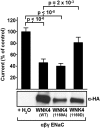An SGK1 site in WNK4 regulates Na+ channel and K+ channel activity and has implications for aldosterone signaling and K+ homeostasis
- PMID: 17360471
- PMCID: PMC1803763
- DOI: 10.1073/pnas.0611728104
An SGK1 site in WNK4 regulates Na+ channel and K+ channel activity and has implications for aldosterone signaling and K+ homeostasis
Abstract
The steroid hormone aldosterone is secreted both in the setting of intravascular volume depletion and hyperkalemia, raising the question of how the kidney maximizes NaCl reabsorption in the former state while maximizing K(+) secretion in the latter. Mutations in WNK4 cause pseudohypoaldosteronism type II (PHAII), a disease featuring increased renal NaCl reabsorption and impaired K(+) secretion. PHAII-mutant WNK4 achieves these effects by increasing activity of the Na-Cl cotransporter (NCC) and the Na(+) channel ENaC while concurrently inhibiting the renal outer medullary K(+) channel (ROMK). We now describe a functional state for WNK4 that promotes increased, rather than decreased, K(+) secretion. We show that WNK4 is phosphorylated by SGK1, a mediator of aldosterone signaling. Whereas wild-type WNK4 inhibits the activity of both ENaC and ROMK, a WNK4 mutation that mimics phosphorylation at the SGK1 site (WNK4(S1169D)) alleviates inhibition of both channels. The net result of these effects in the kidney would be increased K(+) secretion, because of both increased electrogenic Na(+) reabsorption and increased apical membrane K(+) permeability. Thus, modification at the PHAII and SGK1 sites in WNK4 impart opposite effects on K(+) secretion, decreasing or increasing ROMK activity and net K(+) secretion, respectively. This functional state for WNK4 would thus promote the desired physiologic response to hyperkalemia, and the fact that it is induced downstream of aldosterone signaling implicates WNK4 in the physiologic response to aldosterone with hyperkalemia. Together, the different states of WNK4 allow the kidney to provide distinct and appropriate integrated responses to intravascular volume depletion and hyperkalemia.
Conflict of interest statement
The authors declare no conflict of interest.
Figures





Similar articles
-
WNK4 regulates activity of the epithelial Na+ channel in vitro and in vivo.Proc Natl Acad Sci U S A. 2007 Mar 6;104(10):4020-4. doi: 10.1073/pnas.0611727104. Epub 2007 Feb 26. Proc Natl Acad Sci U S A. 2007. PMID: 17360470 Free PMC article.
-
Aldosterone mediates activation of the thiazide-sensitive Na-Cl cotransporter through an SGK1 and WNK4 signaling pathway.J Clin Invest. 2009 Sep;119(9):2601-12. doi: 10.1172/JCI38323. Epub 2009 Aug 17. J Clin Invest. 2009. PMID: 19690383 Free PMC article.
-
WNK4 regulates the balance between renal NaCl reabsorption and K+ secretion.Nat Genet. 2003 Dec;35(4):372-6. doi: 10.1038/ng1271. Epub 2003 Nov 9. Nat Genet. 2003. PMID: 14608358
-
Mechanisms of type I and type II pseudohypoaldosteronism.J Am Soc Nephrol. 2010 Nov;21(11):1842-5. doi: 10.1681/ASN.2010050457. Epub 2010 Sep 9. J Am Soc Nephrol. 2010. PMID: 20829405 Review.
-
[WNK1 and WNK4, new players in salt and water homeostasis].Med Sci (Paris). 2005 Jan;21(1):55-60. doi: 10.1051/medsci/200521155. Med Sci (Paris). 2005. PMID: 15639021 Review. French.
Cited by
-
Anthropogenic events and responses to environmental stress are shaping the genomes of Ethiopian indigenous goats.Sci Rep. 2024 Jun 28;14(1):14908. doi: 10.1038/s41598-024-65303-x. Sci Rep. 2024. PMID: 38942813 Free PMC article.
-
Control of sodium and potassium homeostasis by renal distal convoluted tubules.Braz J Med Biol Res. 2023 Feb 10;56:e12392. doi: 10.1590/1414-431X2023e12392. eCollection 2023. Braz J Med Biol Res. 2023. PMID: 36790288 Free PMC article.
-
The thiazide-sensitive Na+-Cl- cotransporter: molecular biology, functional properties, and regulation by WNKs.Am J Physiol Renal Physiol. 2009 Oct;297(4):F838-48. doi: 10.1152/ajprenal.00159.2009. Epub 2009 May 27. Am J Physiol Renal Physiol. 2009. PMID: 19474192 Free PMC article. Review.
-
WNK4 kinase: from structure to physiology.Am J Physiol Renal Physiol. 2021 Mar 1;320(3):F378-F403. doi: 10.1152/ajprenal.00634.2020. Epub 2021 Jan 25. Am J Physiol Renal Physiol. 2021. PMID: 33491560 Free PMC article. Review.
-
Angiotensin II signaling increases activity of the renal Na-Cl cotransporter through a WNK4-SPAK-dependent pathway.Proc Natl Acad Sci U S A. 2009 Mar 17;106(11):4384-9. doi: 10.1073/pnas.0813238106. Epub 2009 Feb 24. Proc Natl Acad Sci U S A. 2009. PMID: 19240212 Free PMC article.
References
-
- Reilly RF, Ellison DH. Physiol Rev. 2000;80:277–313. - PubMed
-
- Lee DB, Huang E, Ward HJ. Am J Physiol. 2006;290:F20–F34. - PubMed
-
- Lifton RP, Gharavi AG, Geller DS. Cell. 2001;104:545–556. - PubMed
-
- Canessa CM, Schild L, Buell G, Thorens B, Gautschi I, Horisberger JD, Rossier BC. Nature. 1994;367:463–467. - PubMed
Publication types
MeSH terms
Substances
LinkOut - more resources
Full Text Sources
Other Literature Sources
Molecular Biology Databases

